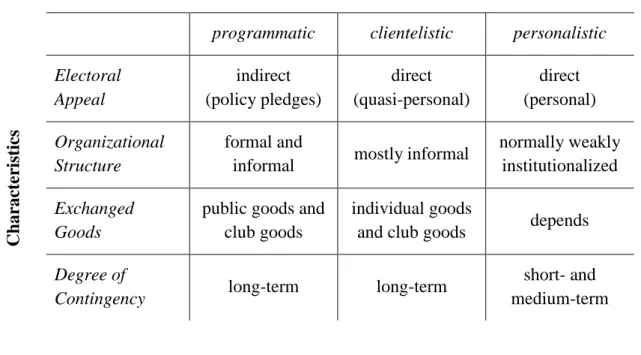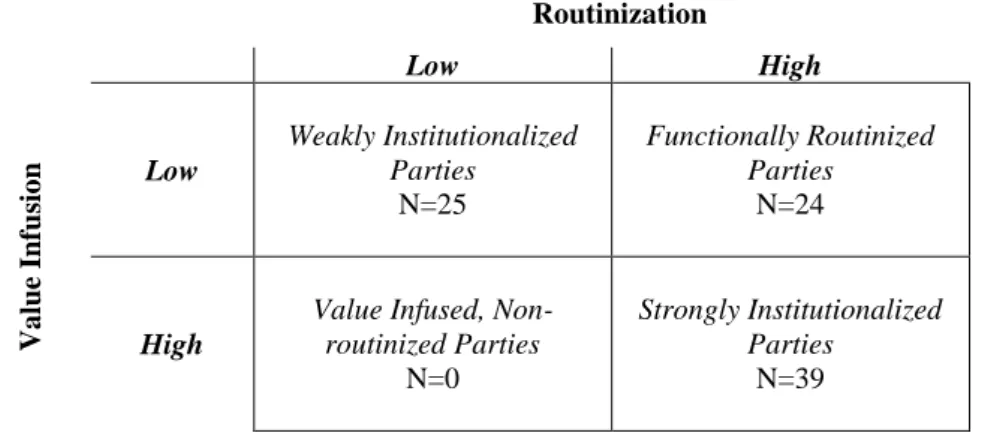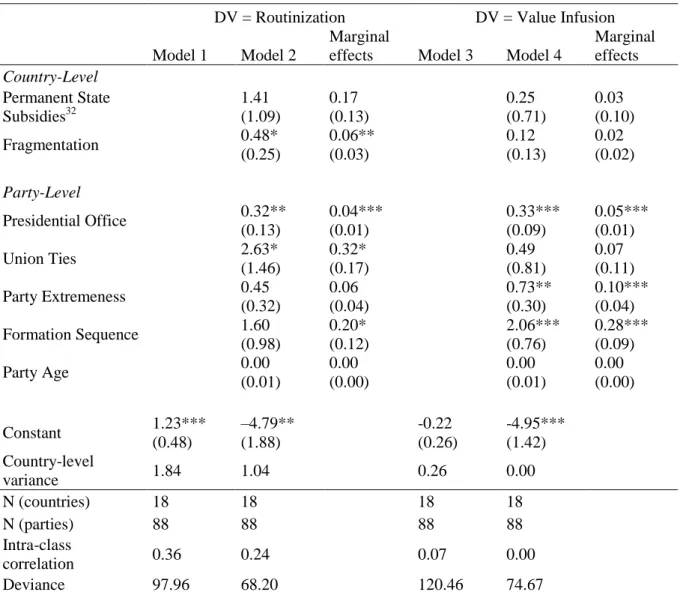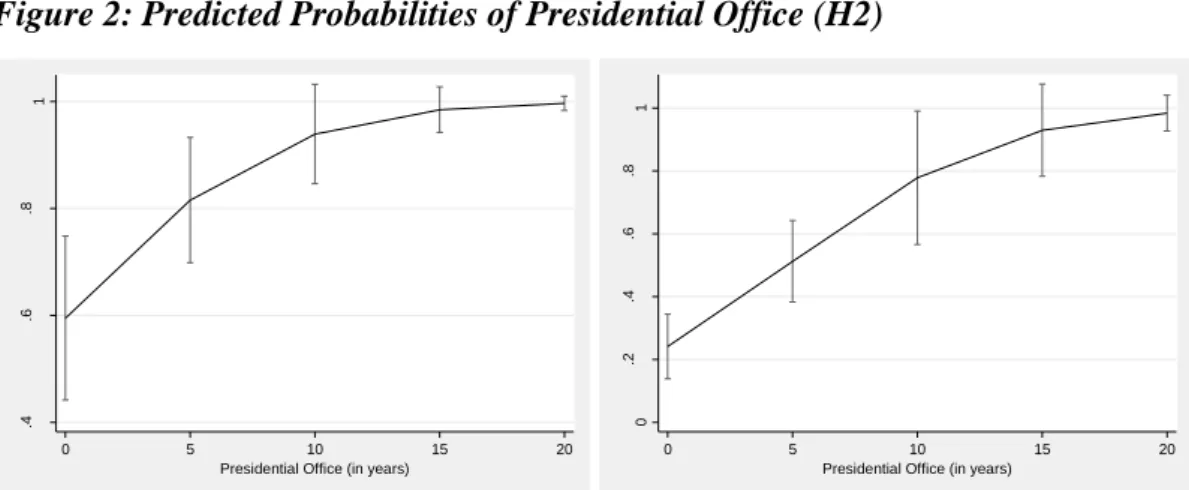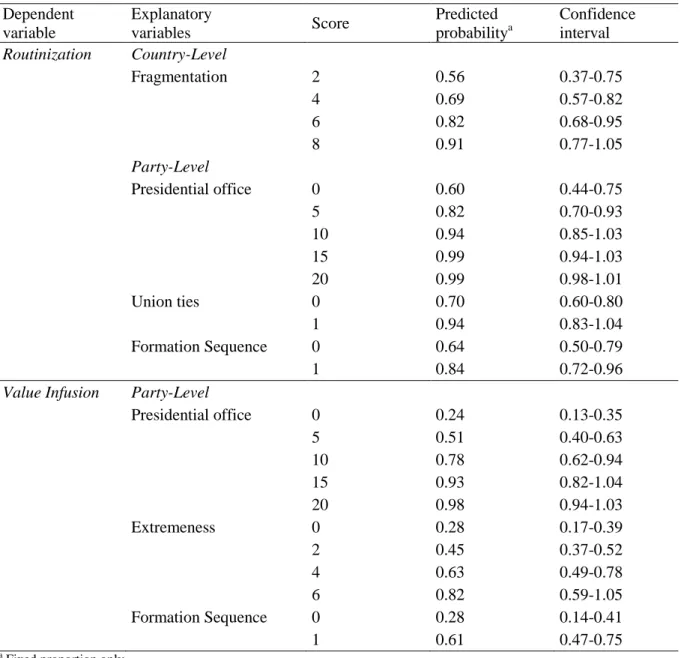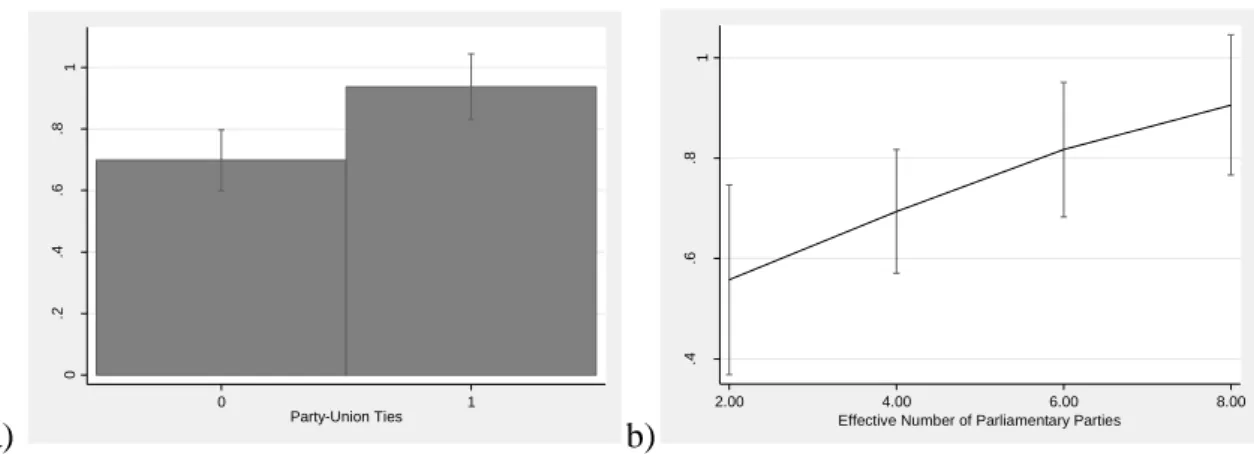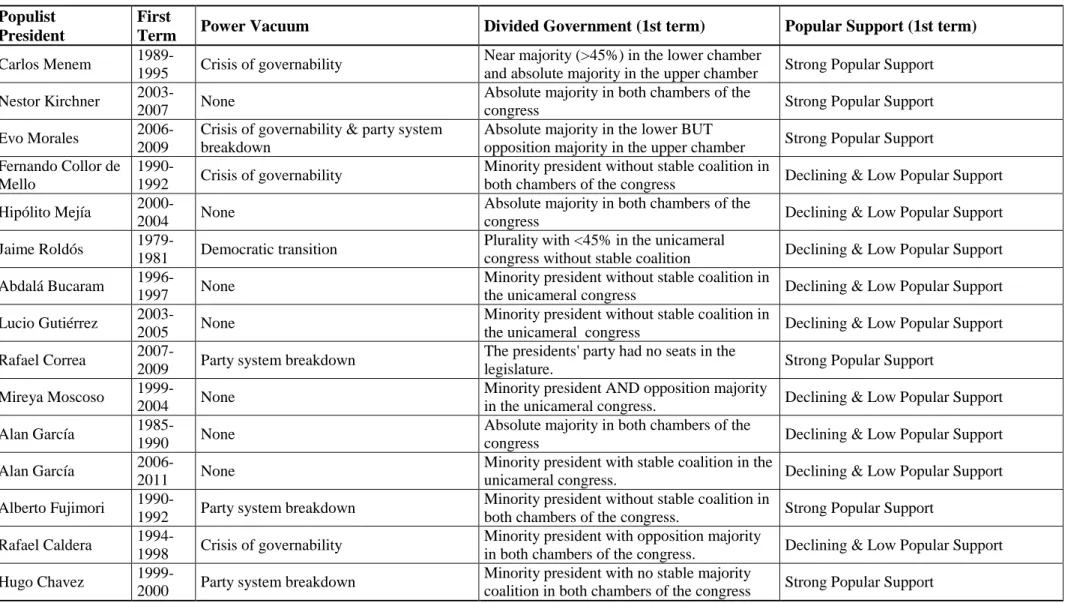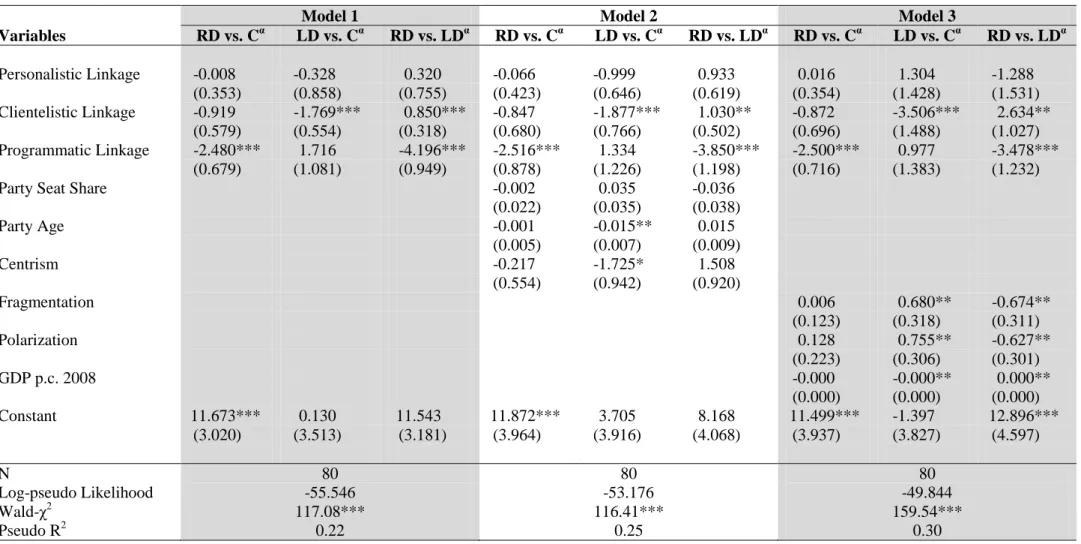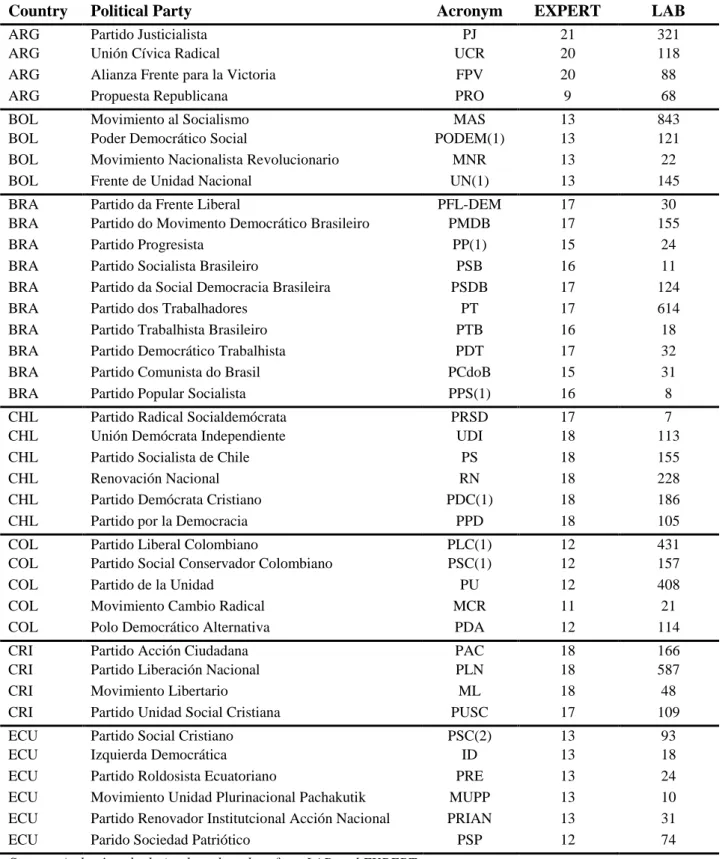The Quality of Representation in Latin America:
Linking Citizens with Political Parties
Inauguraldissertation zur
Erlangung des Doktorgrades der
Wirtschafts- und Sozialwissenschaftlichen Fakultät der
Universität zu Köln
2013
vorgelegt von
Diplom Regionalwissenschaftlerin Lateinamerika Saskia Pauline Ruth aus
Stuttgart
Referent: Prof. Dr. André Kaiser, Universität zu Köln
Korreferent: Juniorprofessor Ingo Rohlfing, PhD, Universität zu Köln
Tag der Promotion: 16. September 2013
Contents
Chapter 1: Introduction
Chapter 2: Party Organization in Latin America: Conceptualizing and Accounting for Diversity (with Nicole Bolleyer)
Chapter 3: Populism in Latin America and the Deconstruction of Horizontal Accountability
Chapter 4: Linkage Strategies and Policy Congruence in Latin American Democracies
Chapter 5: Clientelism and Political Orientation in Latin America
Chapter 1
1
Introduction
“The way parties operate and create linkages of accountability and responsiveness to citizens is likely to have major consequences for the viability of democracy and the quality of its outputs” (Kitschelt et al. 1999: 15)
More than a quarter century has elapsed since the ‘Third Wave’ of democratic transition in Latin America (Huntington, 1991), but political systems in the region still struggle with achieving democratic quality. Representative institutions in this region have not yet reached a self-enforcing equilibrium and continue to produce unfavourable outcomes (Kitschelt et al., 1999). As a consequence, after two decades of research on democratic transition and the consolidation of democracy in Latin America, researchers became increasingly sceptical and concerned with the quality of democratic representation. Several deficits have been identified ranging from the weaknesses of vertical accountability mechanisms (e.g. Moreno, Crisp, &
Shugart, 2003; Roberts, 2002; Coppedge, 2001) and institutions of horizontal accountability
(e.g. Mainwaring & Welna, 2003; O’Donnell, 1994) to the persistence of historical legacies
such as clientelism and populism (e.g. Kitschelt & Wilkinson, 2007; Levitsky & Loxton,
2013). Dysfunctional democratic representation, moreover, fosters growing distrust in
political parties and dissatisfaction with democracy and endangers achievements of
democratic consolidation that have already been made (e.g. Kitschelt et al., 1999; Dalton,
1999; Diamond & Gunther 2001). Hence, the ‘crisis of representation’ in Latin America lies
2
at the heart of any study concerned with the quality of democracy in this region (e.g.
Diamond & Morlino 2005; Mainwaring, Bejarano, & Pizarro, 2006; Hagopian, 1998).
But what are the standards used to evaluate the quality of democratic representation? In line with the competitive model of democracy the quality of democratic representation is usually judged according to the realization of accountability and, especially, policy responsiveness (Schumpeter, 2008 [1942]; Bartolini, 1999, 2000). While repeated elections make political actors accountable to their electorate, competition between these actors for public office and power is believed to make them responsive to the policy preferences of their voters.
Developed with a focus on advanced democracies, traditional theories on democratic representation rest upon the prevalent assumption of policy-based competition between political actors – an assumption which is not directly applicable to the context of new democracies. 1
In new democracies political parties are not necessarily linked to their voters based on coherent policy programs and may pursue additional or completely different electoral mobilization strategies like clientelism and personalistic linkages (Kitschelt & Wilkinson, 2007; Hagopian, 2009). The idealization of policy-based representation through programmatic competition thus hampers awareness from other modes of political representation (Kitschelt, 2000). Linkage strategies that differ from the classic programmatic ones have to be integrated into the concept of party competition if new democracies are to fall into the range of a comprehensive theory of democratic representation (Kitschelt &
Wilkinson, 2007; Powell, 2004). To understand how democratic representation is affected by different linkage strategies we need to investigate how these relationships between political parties and their voters may affect both mechanisms of accountability and policy responsiveness.
1
The assumption even fails to hold in all established democracies since non-programmatic competition is also
observable in some of them, e.g. Italy, Greece, or Belgium (see Piattoni, 2001; Roniger, 2004).
3
This dissertation contributes to the research agenda on the quality of democratic representation in three ways:
(1) I focus on the input-side of the representative process and systematically analyse dysfunctions of policy-based representation. Therefore, it is necessary to acknowledge the variety of mechanisms that establish the representative link between parties and voters. The different linkages which political parties pursue to connect themselves with the electorate ‘set the tone’ for democratic representation on the system level (see Moreno, Crisp, & Shugart, 2003). Hence, with this dissertation I highlight the importance of party-society linkages for both democratic accountability and policy responsiveness in democratic representation. As Biezen and Saward (2008) frame it the focus lies more on the ‘software’ of democratic representation – i.e. the mediating function of political parties – than on the ‘hardware’ of democracy – i.e. the institutions of representative democracy.
(2) By concentrating on a geographical region that has rather been omitted during the development of traditional theories on democratic representation and party competition I challenge their implicit assumptions and generalizability and help to re-assess them. Hence, with the focus on Latin America I seek to delimit travelling potential of concepts to new democracies, and pave the way for them to feedback on explanations of new developments in representative systems of established democracies.
(3) Finally my empirical contribution lies in the creation of an original dataset on populist presidents and parties in Latin America and the compilation of a database on party-society linkages that merges micro-, meso-, and macro-level information from public opinion surveys, expert surveys, and election statistics covering over 20.000 citizens and more than 80 political parties in 18 Latin American countries.
The remainder of this introduction is structured as follows: in section one I discuss the
theoretically beneficial connection between democratic representation and political
4
competition with respect to democratic accountability and responsiveness. In section two I elaborate on different party-society linkages and their consequences for the quality of democratic representation. In section three I introduce the case selection and the data sources.
The last section gives an overview of the four articles that form part of this cumulative dissertation.
Democratic Representation: Accountability and Responsiveness
A key feature of the functioning of representative democracy is competitive interaction between political parties for public office and power. The development of the competitive model of representative democracy dates back to the 1940s and 1950s, with Schumpeter (2008 [1942]), Schattschneider (2009 [1942]), and Downs (1957) as famous defenders of the unintended positive effects of party competition for the public. Although competition is by far not the only form of social interaction possible in a democratic setting 2 , its importance for the quality of democratic representation has often been emphasized in the literature (e.g.
Sartori, 1987; Strøm, 1992). More specifically, political competition is believed to create, as unintended by-products, desirable societal outcomes such as responsiveness (see Bartolini, 1999, 2000; Downs, 1957) and innovation (Franzmann, 2011). 3 Electoral systems and within them political competition are seen as the basic institutional arrangements to implement democratic representation (Powell, 2000). 4
Accountability and policy responsiveness are at the core of both theories on democratic representation and political competition (Pitkin, 1967; Strøm, 1992). Repeated, free, open, secret, and fair elections make political actors accountable to their electorate, and political competition between these actors induces them to be responsive to their voters’ policy
2
E.g. negotiation and cooperation in consensus democracies (Ljiphart, 1999).
3
Franzmann (2011) mentions innovation as a positive by-product of political competition. However, this dissertation focuses on those aspects of democratic representation that impinge on responsiveness.
4
See Powell (2000) on the two visions of electoral systems as instruments of democratic representation.
5
preferences. Policy responsiveness may, thereby, originate in two ways: Firstly, in line with an accountability perspective on democratic representation political competition enables voters to hold their representatives accountable by rewarding or punishing them retrospectively, dependent on their performance in the previous term (see Manin, Przewoski,
& Stokes, 1999). Thereby, institutional mechanisms ideally induce responsive behaviour of representatives to the policy interests of citizens, since these are (according to theory) the voter’s criteria to evaluate whether to sanction them or not. If such institutional accountability arrangements function well, incumbent public officials are induced to be directly responsive to public opinion changes due to ‘rational anticipation’ of the threat of turnover (see Manin, Przeworski, & Stokes, 1999; Stimson, MacKuen, & Erikson, 1995; Wlezien & Soroka, 2007). 5 Secondly, according to the mandate perspective of democratic representation, responsiveness may also originate indirectly when voters select representatives prospectively according to their policy promises and when these representatives are credible to their promises, implementing the policies desired by their voters (see Manin, Przeworski, &
Stokes, 1999).
But, elections alone are not sufficient to make representatives accountable for their actions.
Like all principal-agent relationships, democratic representation may also be jeopardized by shirking, possibly precluding the institutional mechanisms of accountability from inducing responsive behaviour of elected officials (see Kiewiet & McCubbins, 1991; Persson, Roland,
& Tabellini, 1997). Hence, citizens need to be informed to evaluate the behaviour of their elected representatives in office to hold them effectively accountable (e.g. Manin, Pzeworski,
& Stokes, 1999; Schmitter, 2005). Horizontal accountability mechanisms, for example, may provide citizens with necessary information to effectively use vertical accountability mechanisms (see Persson, Roland, & Tabellini, 1997; Moreno, Crisp, & Shugart, 2003).
5
This logic is based on the assumptions that public officials are interested in reelection and have access to
information about public opinion (Stimson, MacKuen, & Erikson, 1995).
6
However, elected representatives will only respond to the policy preferences of their voters (both directly and indirectly) if they are judged and selected by this logic, and voters can only select politicians on this basis if they are offered a clear choice between different and coherent policy programs (Powell, 2000, p. 16). The assumption that democratic representation and political competition are substantially ‘programmatic’ is, however, particularly problematic for emerging democracies. Representative institutions only structure political parties’ scope of action but do not determine they link themselves to their voters (Kitschelt et al., 1999). Consequently, the quality of democratic representation depends on the type of interaction between political parties and voters, i.e. the type of party-society linkages that take hold in a political system. With different forms of party-society linkages prevailing, political competition may foster different forms of accountability and responsiveness. Thus, we need to understand how other forms of accountability relationships may affect the process of democratic representation and we need to understand how policy responsiveness, as one of the most desirable by-product of policy-based competition, is affected by various linkage strategies.
Linking Citizens and Political Parties
This dissertation investigates how political parties’ organizational and substantive links with
their voters affect the quality of democratic representation, i.e. the realization of
accountability and policy responsiveness. Since political parties are the main actors selecting
political elites for elected positions in democratic states their importance for democracy has
often been emphasized in the literature (Sartori, 1976; Mainwaring & Scully, 1995). They
have been labelled “the agents of interest mediation” (Kitschelt et al., 1999, p. 5), or “the
organizations that institutionalize democracy” (Rahat, Hazan, & Katz, 2008, p. 664). Thus,
political parties play a dual role in representative democracies. Contingent on their mediating
7
position between the electorate and political institutions of the state, they are at the same time actors of the state and social organizations (Poguntke, 2002, p. 43). To fulfil their representative function and their role within contemporary democracies, political parties need to be linked with the society. To establish such a representative link with society, political parties, on the one hand, need to build extra-parliamentary organizations to structure their communication with citizens in a durable way. On the other hand, they can pursue different substantive linkage strategies based on programmatic, clientelistic, or personalistic appeals to mobilize electoral support.
The organizational link
To enable political parties to fulfil their mediating function in representative democracies, political competition has to provide at least a minimum of stability. Therefore political parties need to invest in organizational structures in order to connect themselves with the electorate in an on-going way. The strength of organizational party structures is usually captured by the institutionalization concept (Mainwaring & Scully 1995; Huntington, 1968; Panebianco, 1988). Political parties institutionalize when they establish regularized and rule-guided intra- organizational processes (routinization) and/or when they invest in the emotional attachment of their followers through organizational incorporation (value infusion) (Panebianco 1988, p.
49; p. 53). Such institutionalized party organizations are crucial for the stability of intraparty competition and, therefore, one foundation to assure vertical accountability of political representatives to citizens. Weakly institutionalized political parties do not provide channels of communication between citizens and elites, they increase the uncertainty of electoral outcomes, and deprive voters of meaningful choices (e.g. Mainwaring & Scully, 1995;
Mainwaring & Torcal, 2006). Furthermore, political parties that are organizationally linked
with society can help counter anti-party sentiments and alienation from politics that are wide-
8
spread among citizens in Latin American democracies (see Payne, 2006). The reasons why political parties invest in extra-parliamentary organizations, their contribution to the institutionalization of party systems, and the viability of vertical accountability are analysed in the first article of this dissertation (Chapter 2). However, organizational stability is only one factor of meaningful intraparty competition, political parties also need to represent their voters’ policy interests and aggregate them into coherent policy programmes to assure the beneficial outcomes of the competitive model of democracy. Hence, I now turn to such substantive linkages between citizens and political parties.
The linkage concept
The substantive relationship between political parties and the electorate is illustrated through the linkage concept (Kitschelt, 2000; Poguntke, 2000, 2002). In general, the concept describes an interactive connection between the electorate and the state mediated by political elites. This linkage is driven by political parties’ needs for votes to win elections and to secure their survival, irrespective of their office, vote or policy motivations (Poguntke, 2000, 2002).
Linkage forms are usually distinguished according to three factors: (1) Electoral appeal: To
connect themselves with the electorate, political parties may address voters either in a direct
way (e.g. personal contact, mass media) or in an indirect way (e.g. policy pledges). (2)
Character of organizational relations: Political elites may connect themselves to the voter
through organizational structures (e.g. collateral organizations, social networks). Formal
organizational ties are based on the integration of other political actors into a party’s
decision-making process, whereas informal ties are based on loyalty, pressure or
blackmailing (Poguntke, 2002, p. 47). (3) Kind of exchanged goods: Political parties may
offer either private, club, or public goods in exchange for the vote of their constituency.
9
Roberts (2002) adds another dimension to distinguish party-society linkages: (4) their degree of contingency. This characteristic refers to the time it takes to build a specific linkage type, i.e. how much they rely on the generation of trust, loyalty, and credibility. In this respect linkages may be distinguished according to their short-, medium- or long-term character.
Classically three forms of linkages between political parties and society are mentioned in the literature: programmatic, clientelistic, and personalistic linkages (see Table 1 for an overview of the characteristics of each linkage strategy). These linkage forms are not mutually exclusive. Political actors may pursue different forms of linkages at the same time. It may even be a viable strategy of risk avoidance to pursue a strategic mix of linkage forms (see Magaloni, Diaz-Cayeros, & Estévez, 2007).
Table 1: Linkage strategies of political parties
Linkage Types
programmatic clientelistic personalistic
Charac te ristics
Electoral Appeal
indirect (policy pledges)
direct (quasi-personal)
direct (personal) Organizational
Structure
formal and
informal mostly informal normally weakly institutionalized Exchanged
Goods
public goods and club goods
individual goods
and club goods depends Degree of
Contingency long-term long-term short- and
medium-term
Programmatic Linkage
In line with the model of ‘responsible party government’ (APSA, 1950; Downs, 1957),
political parties pursuing a programmatic linkage strategy appeal to their voters with policy
programs. These programs entail an ideal of the greater good to the advantage of the whole
10
society (Pappi, 2000). In this sense parties make indirect policy pledges to a large range of voters which have their own policy preferences and base their electoral decision on them.
To root themselves in society political parties maintain formal and informal organizational relations with their social base. The most obvious connection between party elites and their voters is a party membership organization. Other organizational linkages are collateral organizations – like unions or churches – and social movements. Characteristic of these forms of organizations is a horizontal bottom up style that enhances participation and interest aggregation (Kitschelt, 2000; Roberts, 2002). As programmatic parties base their policy programmes on an ideal of the greater good, they are able to offer public policy to their voters. But political parties may also concentrate on specific, distinguishable social groups and, hence, provide club goods (pork-barrel politics). Programmatic party competition may in this sense be directed at the general public as well as particularistic groups (Kitschelt &
Wilkinson, 2007). The more informally or formally attached programmatic parties are to
civil society organizations, the more durable and stable is their linkage (Poguntke, 2000,
2002). Thus, linking a political party in programmatic ways to the electorate may be labelled
a long-term strategy. Accordingly, the programmatic linkage demands heavy investments of
political elites. Firstly, they have to bear the costs of building organizational structures to
solve collective action problems and offer mechanisms of interest aggregation (Kitschelt,
2000). Secondly, programmatic linkages are based on trust and credibility and prone to path
dependency effects. If victorious political parties defect from their policy pledges or engage
in extreme policy switches over time they may lose the support of even loyal voters in
subsequent elections (Stokes, 1999). Hence, political parties linked to their supporters
through policy pledges ideally hold themselves responsive to their voters’ policy preferences
(Manin, Przeworski, & Stokes 1999). Furthermore, programmatic parties that link themselves
to the society based on coherent policy pledges provide for other modes of political
11
participation than just voting. Voters may partake in procedures of interest aggregation through party membership organizations or as members of collateral organizations linked to political parties based on congruent policy positions (Kitschelt, 2000). The connection between a programmatic linkage strategy and the policy congruence between political parties and their supporters plays a role in the third article of this dissertation (Chapter 4). But, political parties in new democracies are often not linked to their voters based on coherent policy programs. They may also pursue other linkages with society like clientelistic and personalistic linkages (Kitschelt & Wilkinson, 2007, p. 3). I turn now to these other forms of party-society linkages.
Clientelistic Linkage
The concept of clientelism is widely used and referred to in very different contexts. Thus, it is prone to conceptual stretching (Piattoni, 2001). Different definitions of clientelism are owed to the changing role of patron-client relationships over time and to different research interests. According to the origins of the concept, traditional clientelism describes a dyadic, personal relationship between unequals that builds on fear or obligation as bonds 6 . But modern clientelism differs from this older version in some aspects. First of all, the patron becomes a political party that wants to mobilize electoral support. In addition, the contemporary clientelistic linkage is no more limited to face-to-face contacts but may also be based on group relations (see for example Roniger, 1994, 2004; Piattoni, 2001; Hopkin, 2006).
I follow a conception of clientelism that focuses on those qualities of the phenomenon which directly relate to the electoral process (see Kitschelt, 2000; Kitschelt & Wilkinson, 2007;
Piattoni, 2001; Stokes, 2007).The clientelistic linkage is defined as a “direct exchange of a
6
This depiction of clientelism refers to “an archaic phenomenon of traditional and agrarian societies” (Roniger,
2004, p. 355).
12
citizen’s vote in return for direct payments or continuing access to employment, goods, and services” (Kitschelt & Wilkinson, 2007, p. 2). This general definition covers both patronage and vote buying, as specific subtypes of clientelistic exchange. Following Stokes, these subtypes are defined as follows: patronage is “the proffering of public resources (most typically, public employment) by office-holders in return for electoral support” (2007, p. 606, italics original), whereas “vote buying is a more narrow exchange of goods (benefits, protections) for one’s own vote” (2007, p. 606, italics original). 7 Clientelistic exchange, thus, takes place closely before or after an election was held (Kitschelt & Wilkinson, 2007).
Furthermore, the clientelistic linkage is characterized through conditionality, i.e. a quid pro quo. In order to avoid the risk of opportunistic defection, clientelistic parties need to build enforcement mechanisms (i.e. monitoring) to guarantee the exclusiveness of the clientelistic exchange. Target identifyability and excludability are important features of clientelistic exchange relationships. Potential groups for this exchange, thus, have to be clearly delineated. Therefore clientelistic parties have to make investments in organizational infrastructure to identify and monitor potential voters (Kitschelt, 2000). These organizational ties are mostly informal and structured in a hierarchical top down manner (Gay, 1998).
Clientelistic parties rely on vertical exchange networks between party elites, party brokers, and clients that organize the complex transport of benefits from the top level of the party organization to the bottom in exchange for votes (Roberts, 2002; Levitsky, 2001). The role of party brokers in these networks is to connect party elites with their constituencies. In this respect, informality should not be confounded with lack of organization or institutional weakness (Levitsky, 2001).
7
Other materially oriented political strategies are pork-barrel politics and programmatic redistributive politics.
But both of these strategies do not deliver small-scale exclusive goods, although pork-barrel politics may be a
source of patronage when realized (Stokes, 2007).
13
Due to their direct appeal, goods offered for exchange by clientelistic parties are first and foremost characterized by exclusiveness, i.e. they provide mainly private and club goods. 8 Thus, clientelism “focuses the popular sector’s attention on the immediate acquisition of localized and small-scale goods and services as opposed to a series of more significant, generalized and long term demands” (Gay, 1998, p. 11). Since the clientelistic linkage relies on direct material inducements, this strategy becomes more likely the more voters value such side payments and the lesser they value future benefits from the provision of public goods (Kitschelt, 2000). 9
Concerning the degree of permanence, clientelistic linkages have a long-term character. In general the decline of clientelism has often been predicted, but in fact it has proven to be a highly adaptive strategy even in democratic contexts (see Roniger, 2004; Gay, 1998). This may be because the relationship with the voter is often marked by a dependency aspect and built on repetition (Stokes, 2007). In addition, the party organization as a social network plays an important role in binding voters over time. Thus, similar to programmatic parties, clientelistic practices are based on trust and credibility and thus also prone to path dependency effects (Roniger, 1994).
Political parties that choose a clientelistic linkage strategy have to invest in mechanisms of voter supervision, i.e. monitoring, and they have to build “organizational hierarchies of exchange between electoral clients at the ground floor of the system, various levels of brokers organized in pyramidal fashion, and patrons at the top” (Kitschelt & Wilkinson, 2007,p. 8).
Thus, transaction costs for providing the exchanged benefits are high.
Since the relationship between clientelistic parties and their voters is often marked by a dependency aspect and built on repetition, clientelistic parties may take advantage of poverty
8
Stokes (2007) distinguishes clientelistic club good provision from pork-barrel politics by means of a distributive criterion: benefits from pork-barrel politics are distributed in a whole district and, therefore, non- clientelistic voters in this district cannot be excluded.
9
See Stokes (2007, pp. 617-619) for a comprehensive overview of the relationship between clientelism and
poverty.
14
and lack of autonomy of poor voters (see Taylor-Robinson, 2010; Fox, 1994; Bruso, Nazareno, & Stokes, 2004). This may lead to situations of ‘perverse accountability’ with respect to the electoral process (Stokes, 2007; Stokes, 2005). The more dependent clients are on material benefits and the better clientelistic party brokers can monitor their behaviour, the more likely clients can be held accountable for not voting for the clientelistic party.
Furthermore, clientelistic linkages as opposed to programmatic linkages “reduce parties to their most basic, self-referential political function: electing candidates from their ranks into public office” (Roberts, 2002, p. 29). On the one hand, parties pursuing a clientelistic strategy do not provide their voters with mechanisms of interest aggregation; they do not offer orientation in the policy space to their voters, and may even cut across cleavages and cater for highly heterogeneous clients (Gay, 1998; Roberts, 2002). On the other hand, voters in clientelistic relationships, in turn base their voting decision on the exchange of material benefits. The voting act thus loses its capacity to signal policy preferences. Consequently, votes obtained in this way do not entail any information about the policy interests of the voter and are therefore useless for the prospective or retrospective evaluation of a representatives’
policy responsiveness (see Schaffer, 2007; Stokes, 2007; Zechmeister, 2010). Although there may be some kind of clientelistic responsiveness, in order to evaluate the quality of democratic representation only policy responsiveness is of relevance. The effect of the clientelistic linkage on the quality of democratic representation is analysed in two articles of this dissertation. The third article investigates the negative and distortive effects of clientelism on party-voter congruence as an indicator of policy responsiveness (Chapter 4).
The fourth article focusses on the effect of clientelism on voters’ uncertainty in the political
realm and their ability to form clear and structured policy preferences (Chapter 5).
15 Personalistic Linkage
This linkage form may also be labelled charismatic or populist appeal. Political parties that maintain such bonds with their voters base their strategy on the personal skills of one or a few (charismatic) leaders. Often these parties are referred to as mere electoral vehicles (Roberts, 2002; Kitschelt, 2000). A personalistic party reaches its voters through a direct, personal appeal (often combined with marketing techniques). Its organizational structure tends to be weakly institutionalized, since party leaders do not want to limit their leverage on the intraparty decision-making process (Weyland, 1999; Kitschelt, 2000). In analogy to this, the pledges personalistic parties make to their voters remain opaque. Party leaders “tend to promise all things to all people to maintain maximum personal discretion over the strategy of their party vehicle” (Kitschelt, 2000, p. 849).
If political parties are mere electoral vehicles for a charismatic leader they are likely to be of short- or medium-term character since the bond with their voters will probably dissolve as soon as the charismatic leader dies or finishes her career. Therefore, to secure the long-term success of a personalistic party “charismatic leaders or their successors will be forced to routinize authority relations and put them on a different grounding” (Kitschelt, 2000, p. 855).
Only when the personalistic linkage is combined with a long-term linkage strategy, the risk of an ephemeral life-span may be diminished. The charismatic linkage is combinable with all the linkage types already mentioned (Roberts, 2006). For itself, the personalistic linkage does neither solve collective action problems nor offer alternative forms of participation and techniques of interest aggregation to voters (Kitschelt, 2000).
Closely related to the personalistic linkage type is the phenomenon of populism. Populist
parties usually exhibit a direct, unmediated electoral appeal through charismatic leaders,
hence, they have an affinity to the personalistic linkage type (Weyland, 2001). In general, the
populist ideology is based on the division of the society in two homogeneous and antagonistic
16
groups: the people versus the elite (Mudde, 2004; Barr, 2009). The exact content of this ideology depends on secondary elements that may be combined with such an appeal (Abts &
Rummens, 2007). Regarding the organizational structure populism is normally associated with an uninstitutionalized form of party organization. In the extreme populists use their parties as mere electoral vehicles (again in line with the personalistic linkage type). But there are also populist parties which invested in the institutionalization of their organizational structure (e.g. traditional populist parties). Furthermore, the kind of exchanged goods depends on whether a populist party integrates other ideological elements, pursues specific policy programs, or relies on the support of specific groups of voters. Regarding the degree of contingency, populist appeals are often used by new political parties or new politicians within an existing political party. As such populism seems to be a viable electoral entry strategy to challenge established elites. But populism is also often said to be a transitory phenomenon.
Many populists face the problem to maintain the electoral support of the (heterogeneous) discontent mass they promised to represent as soon as they achieve government responsibility. And soon after those populist challengers emerged and took over government (or participated in it), they faded away (Weyland, 2001, Taggart, 2004).
It has been argued in the literature that populism in power has a fierce relationship with democratic representative institutions (e.g. Rovira, 2012; Plattner, 2010). Populism in power may severely affect both the horizontal and vertical dimension of democratic accountability.
Especially in presidential systems like those in Latin America, populist presidents face
incentives to change the political regime to their own benefit through institutional reform,
manipulation of democratic rules, or through the execution of a coup d’état. Therefore, the
second article of this dissertation systematically analyses the opportunity structure of populist
presidents incentivizing a radical change of checks and balances in Latin American
democracies (Chapter 3).
17 Case Selection and Data
Research on democratic representation identified great differences of political parties and party systems between new and established democracies respectively. For example, Latin American party systems are barely institutionalized and volatility in the region is much higher than in Western European democracies (Mainwaring & Scully, 1995; Mainwaring &
Torcal, 2006). Moreover, party organizations are less based on party membership than their Western European counterparts and competition structures between political parties are often shaped by clientelistic and personalistic means (Coppedge, 2001; Kitschelt & Wilkinson, 2007). Furthermore, comparing Latin American democracies, Kitschelt et al. (2010) show that the degree of programmatic party system structuration differs greatly in the region. On the one hand, we thus find differences in the structuration of democratic representation between new and established democracies as well as variation within the Latin American region with respect to the utilization of different linkage strategies. Therefore, Latin American democracies offer suitable units of observation to investigate the influence of party-society linkages on the quality of democratic representation. On the other hand, Latin American democracies are ‘most similar cases’ with respect to their institutional and socio- economic contexts (see Przeworski & Teune, 1970). For example, many Latin American countries experienced phases of military rule during the 1970s and phases of re- democratization in the 1980s and 1990s (e.g. Hagopian & Mainwaring, 2005; O’Donnell &
Schmitter, 1986). In addition to this, all countries in this study are presidential regimes and
share similar structures of vertical and horizontal accountability (Linz, 1994; O’Donnell,
1994; Mainwaring & Welna, 2003). Latin American presidents are usually perceived to be
powerful actors within their political systems, either because they possess strong
constitutional powers – like a presidential veto or executive decree authority – or because
they rely on strong partisan powers – i.e. majority support in the legislative branch and high
18
party discipline (Shugart & Carey 1992; Mainwaring & Shugart 1997). Furthermore, most of the countries studied here deploy pure PR electoral systems for the lower chamber of their legislatures, and the two exceptions, Bolivia and Mexico, use semi-proportional electoral systems (Wills-Otero, 2009, pp. 38–39). With respect to the socio-economic context, Latin America is a region plagued with high income inequality, a large informal sector, and
‘truncated’ welfare states, benefiting only those with formal employment (Díaz-Cayeros &
Magaloni 2009; Rudra, 2004). Furthermore, the Latin American region shares a historical legacy of the Import Substitution Industrialization (ISI) era that led to continuing financial crisis in the 1980s as well as the adoption of neoliberal policies in the 1990s (Huber &
Stephens, 2010; Filgueira & Luna, 2009; Remmer, 1990).
Both presidential regimes and economic inequality are features that are related to different
party-society linkages. Presidentialism, on the one hand, incentivizes the use of a
personalistic linkage type through a higher degree of personalization and a direct, unmediated
legitimacy of the president (O’Donnell, 1994, Linz, 1994). High poverty rates and high
degrees of income inequality, on the other hand, make the clientelistic linkage type more
viable for political actors (Kitschelt & Wilkinson, 2007; Stokes, 2007). Thus, differences in
regime type and socio-economic conditions may cause political actors to pursue linkages
other than the programmatic one, accounting for their variation compared to established
democracies and the variation between Latin American democracies. However, the main
focus of this dissertation lies on the association between different organizational and
substantive linkages between citizens and political elites on the quality of democratic
representation. Consequentially, the general institutional and socio-economic contexts in
Latin America are either controlled for in the statistical analysis or considered a scope
condition in this study.
19
To assess the relationship between party-society linkages and the quality of democratic representation this dissertation makes use of the growing availability of comparative data based on public opinion, elite-, and expert surveys. For the statistical analyses in this study, the following data sets have been combined to address different questions on the quality of the representational link in Latin America:
(1) Micro level data on citizens in Latin American democracies is provided by two public opinion surveys: the Latinobarometer and the Americas Barometer. Firstly, the Corporación Latinobarómetro conducts its public opinion survey on a yearly basis including a large range of questions on attitudes, values, and the behaviour of citizens as well as socio-demographic information about the respondents (Corporación Latinobarómetro, 2010). Starting with eight democracies in 1995 more and more countries have been added over the years, and since 2004 the survey covers the following 18 Latin American democracies: Argentina, Bolivia, Brasil, Chile, Colombia, Costa Rica, Dominican Republic, Ecuador, El Salvador, Guatemala, Honduras, Mexico, Nicaragua, Panama, Paraguay, Peru, Uruguay, and Venezuela.
Furthermore, the survey instruments have been refined over time and the representativeness of the country samples has been increased to approximately 100% covering both urban and rural regions (Corporación Latinobarómetro, 2010). Secondly, the Latin American Public Opinion Project (LAPOP) issues the AmericasBarometer on democratic values and behaviours every two years since 2004. The survey is based on face to face interviews with voting-age adults in 26 countries in North, Central and South America, and the Caribbean.
Systematic pre-tests in each country and probability samples ensure the representativeness of the survey both on national and subnational levels (see LAPOP, 2012).
(2) Meso level data on political parties’ linkage strategies is provided by the recently
compiled Democratic Accountability Expert Survey (DAES - Altman et al., 2009; Kitschelt
et al., 2009). This survey was specifically designed to uncover the different relationships
20
political parties may pursue with their voters in representative democracies. The research instruments are based on the concept of party-society linkages proposed by Kitschelt (2000) and, therefore, they tie in perfectly with the theoretical arguments made in this dissertation.
Besides questions on these linkages, the survey includes questions on political parties’
organizational structures as well as their policy positions on several issue dimensions. The whole project covers 85 electoral democracies in Africa, the Americas, Asia-Pacific, Europe, and the Middle East. More specifically, for the Latin American part of the survey experts have been asked to rate over 80 political parties. This rich source of data is further extended by original qualitative information on political parties based on case studies and online resources (more detailed information is provided in the respective articles of this dissertation).
(3) Macro level data on party system characteristics have been systematically compiled by the author merging several sources. Comparative cross-national information on political parties’ vote and seat shares in Latin American legislatures are scarce and often diverge dependent on the purpose and scope of the respective source (e.g. Nohlen, 2005; IPU, 2013;
OIR, 2013). Problematic are especially the handling of small parties, the information on party
splits and mergers, as well as the treatment of the frequent praxis in the region of renaming
political parties. Therefore, to systematically evaluate party system characteristics in Latin
American countries these comparative cross-national databases have been compared with
national election statistics as well as research notes on specific legislative and presidential
elections resulting in a unique data set that includes small parties and accounts for party
splits, party mergers, as well as party renaming.
21 Overview
This dissertation consists of four articles each highlighting a different aspect of the association between political parties’ linkages with society and the quality of democratic representation. The first and the second article (Chapter 2 and 3), thereby, are concerned with the relationship between party-society linkages and mechanisms of democratic accountability, the third and fourth article (Chapter 4 and 5) assess the relationship between party-society linkages and policy responsiveness.
Chapter two focusses on the empirical diversity of party organizations and the incentive structure of political elites to invest in extra-parliamentary party building in Latin America.
By specifying the conditions that make the adoption of an institutionalized party organization more likely, this co-authored article (with Nicole Bolleyer) addresses an important empirical gap. 10 Furthermore, it contributes to the debate on the important role political parties play with respect to the viability of vertical accountability mechanism in the context of new democracies (Diamond & Gunther, 2001; Diamond & Morlino, 2005; Mainwaring, Bejarano,
& Pizarro, 2006).
In this article we refer to the institutionalization concept that has been fruitfully applied to study party evolution in various contexts already (Mainwaring & Scully 1995; Huntington 1968; Panebianco 1988). In terms of parties’ organizational evolution discussions evolved around two core dimensions of institutionalization that shape the nature of parties’ internal life: value infusion and routinization (e.g. Panebianco, 1988; Levitsky, 1998). Using expert survey data covering organizational characteristics of more than 80 parties within 18 Latin American countries we map out the diversity of party organization in Latin America across parties and countries. By doing so, we examine the usefulness of the conceptual tool in an
10
